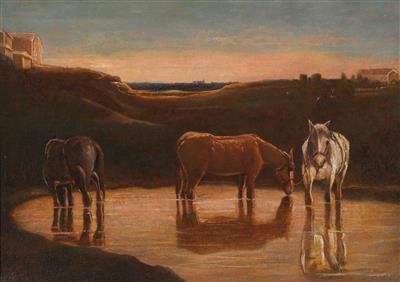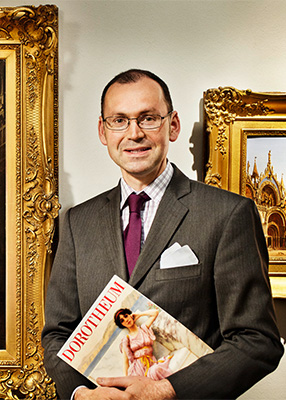Giovanni Segantini

(Arco 1858–1899 Schafberg near Pontresina)
Cavalli al guado, (Horses at the Ford), monogrammed GS, on the reverse inscribed “Dipinto di Giovanni Segantini da me ripulito 11 maggio 1947, G. Mascarini. pittore” and “Confermo quanto sopra in fede Gottardo Segantini Milano 9. I. 1948”, ca. 1882–1883, oil on canvas, 50 x 70 cm, framed, (GG)
Provenance:
European private collection.
Exhibited:
Como, Palazzo del Broletto, Il Divisionismo italiano, 13 April - 18 May 1989;
St. Moritz, Segantini Museum, Il Divisionismo della Galleria Grubicy, 4 December 1990 – 30 January 1991.
Compare:
Prof. Dr. Annie-Paul Quinsac, Segantini, Catalogo generale, ed. Electa, Milan 1982, Volume II, no. 377–385, p. 309–312.
Photo certificate issued by Prof. Dr. Annie-Paul Quinsac, dated 30 March 1989, available.
Giovanni Segantini was born in Arco in the province of Trento. In 1865, after the death of his mother, he moved with his father to live with his stepsister in Milan. A year later his father also died. Segantini had a difficult childhood as an orphan. From 1873-1874 he worked in his half-brother Napoleone’s photographic studio in Borgo Val Sugana, and from 1875-1876 he worked with the sign-painter Luigi Tettamanzi in Milan. He attended the Brera art academy here from 1875-1879, taking part in the Brera exhibition of 1879 with his painting The Chancel of Sant’Agostino in Milan (oil on canvas, 119.5 x 85 cm, Pinacoteca di Brera, Milan), now regarded as the artist’s first important work. During the same year he met Vittore Grubicy with whom he immediately entered into a contract, as did his artist colleague Emilio Longoni. From 1883 to 1886 Vittore Grubicy had the right to sign Segantini’s works with the monogram “GS“.
In 1882 Giovanni Segantini moved with Bice Bugatti, the sister of Art Nouveau cabinetmaker Carlo Bugatti, to the Brianza, the region between Milan and Lake Como. Here the Segantinia family lived consecutively in Pusiano, Carella and Corneno. The artist spent his time studying rural life, executing many still lifes and portraits. The works from this period still remain strongly influenced by the Lombardy tradition.
After moving to Savognin (Grisons) in 1886, Segantini abandoned the academic style and turned to new forms of expression. His painting becomes colourful and, although he remains true to his primary subject of peasant and shepherd lives, emotional genre painting gives ways to realistic scenes of astounding directness and spontaneity. Nature becomes more important, and he searches for a greater balance between the human and natural worlds.
Segantini first began to consider Symbolism during his time in Savognin, influenced by illustrations of the Pre-Raphelites, imaginary stories and poems; the artist is inspired by an Indian poem in his paintings The Bad Mothers (1894, oil on canvas, 99 x 173 cm, Walker Art Gallery, Liverpool) and The Bad Mothers (1894, oil on canvas, 120 x 225 cm, Kunsthistorisches Museum, Vienna) which was adapted by Luigi Illica and translated into Italian.
During the 1890s Segantini’s Divisionist style began to take on its own character: the fine brushstrokes with their thick layers of oil create the impression of homogenous, carefully made textiles. The artist was already world-famous by this time. Alberto Grubicy exhibited Segantini‘s works in major cities, and many paintings were acquired at that time by some of the world’s most important museums.
This newly discovered work is a variation on the painting published in the complete catalogue (A.P. Quinsac, Segantini, catalogo generale, Volume II, no.377, p.309). The landscape is set by Lago del Segrino at dusk, the surroundings are true to nature.
The artist used the motif of horses at a ford several times, obviously to study the horses’ various postures and how their reflections are backlit in the water. Segantini would only solve the problem of representing light five years later, using Divisionist techniques of painting.
Specialist: Gautier Gendebien
 Gautier Gendebien
Gautier Gendebien
+39-334-777 1603
Gautier.Gendebien@dorotheum.it
08.04.2014 - 18:00
- Estimate:
-
EUR 40,000.- to EUR 50,000.-
Giovanni Segantini
(Arco 1858–1899 Schafberg near Pontresina)
Cavalli al guado, (Horses at the Ford), monogrammed GS, on the reverse inscribed “Dipinto di Giovanni Segantini da me ripulito 11 maggio 1947, G. Mascarini. pittore” and “Confermo quanto sopra in fede Gottardo Segantini Milano 9. I. 1948”, ca. 1882–1883, oil on canvas, 50 x 70 cm, framed, (GG)
Provenance:
European private collection.
Exhibited:
Como, Palazzo del Broletto, Il Divisionismo italiano, 13 April - 18 May 1989;
St. Moritz, Segantini Museum, Il Divisionismo della Galleria Grubicy, 4 December 1990 – 30 January 1991.
Compare:
Prof. Dr. Annie-Paul Quinsac, Segantini, Catalogo generale, ed. Electa, Milan 1982, Volume II, no. 377–385, p. 309–312.
Photo certificate issued by Prof. Dr. Annie-Paul Quinsac, dated 30 March 1989, available.
Giovanni Segantini was born in Arco in the province of Trento. In 1865, after the death of his mother, he moved with his father to live with his stepsister in Milan. A year later his father also died. Segantini had a difficult childhood as an orphan. From 1873-1874 he worked in his half-brother Napoleone’s photographic studio in Borgo Val Sugana, and from 1875-1876 he worked with the sign-painter Luigi Tettamanzi in Milan. He attended the Brera art academy here from 1875-1879, taking part in the Brera exhibition of 1879 with his painting The Chancel of Sant’Agostino in Milan (oil on canvas, 119.5 x 85 cm, Pinacoteca di Brera, Milan), now regarded as the artist’s first important work. During the same year he met Vittore Grubicy with whom he immediately entered into a contract, as did his artist colleague Emilio Longoni. From 1883 to 1886 Vittore Grubicy had the right to sign Segantini’s works with the monogram “GS“.
In 1882 Giovanni Segantini moved with Bice Bugatti, the sister of Art Nouveau cabinetmaker Carlo Bugatti, to the Brianza, the region between Milan and Lake Como. Here the Segantinia family lived consecutively in Pusiano, Carella and Corneno. The artist spent his time studying rural life, executing many still lifes and portraits. The works from this period still remain strongly influenced by the Lombardy tradition.
After moving to Savognin (Grisons) in 1886, Segantini abandoned the academic style and turned to new forms of expression. His painting becomes colourful and, although he remains true to his primary subject of peasant and shepherd lives, emotional genre painting gives ways to realistic scenes of astounding directness and spontaneity. Nature becomes more important, and he searches for a greater balance between the human and natural worlds.
Segantini first began to consider Symbolism during his time in Savognin, influenced by illustrations of the Pre-Raphelites, imaginary stories and poems; the artist is inspired by an Indian poem in his paintings The Bad Mothers (1894, oil on canvas, 99 x 173 cm, Walker Art Gallery, Liverpool) and The Bad Mothers (1894, oil on canvas, 120 x 225 cm, Kunsthistorisches Museum, Vienna) which was adapted by Luigi Illica and translated into Italian.
During the 1890s Segantini’s Divisionist style began to take on its own character: the fine brushstrokes with their thick layers of oil create the impression of homogenous, carefully made textiles. The artist was already world-famous by this time. Alberto Grubicy exhibited Segantini‘s works in major cities, and many paintings were acquired at that time by some of the world’s most important museums.
This newly discovered work is a variation on the painting published in the complete catalogue (A.P. Quinsac, Segantini, catalogo generale, Volume II, no.377, p.309). The landscape is set by Lago del Segrino at dusk, the surroundings are true to nature.
The artist used the motif of horses at a ford several times, obviously to study the horses’ various postures and how their reflections are backlit in the water. Segantini would only solve the problem of representing light five years later, using Divisionist techniques of painting.
Specialist: Gautier Gendebien
 Gautier Gendebien
Gautier Gendebien
+39-334-777 1603
Gautier.Gendebien@dorotheum.it
|
Buyers hotline
Mon.-Fri.: 10.00am - 5.00pm
kundendienst@dorotheum.at +43 1 515 60 200 |
| Auction: | 19th Century Paintings |
| Auction type: | Saleroom auction |
| Date: | 08.04.2014 - 18:00 |
| Location: | Vienna | Palais Dorotheum |
| Exhibition: | 29.03. - 08.04.2014 |
